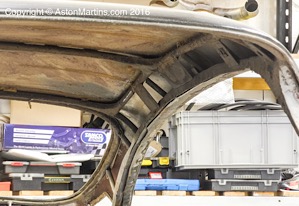Glossary of Aston Martin Terms
If you’re new the the fascinating world of Aston Martins, this this glossary may help you. Words like ‘superleggera’ ‘kamm tail’ and ‘cosmetic’ often cause confusion so this section is here to demystify things a little. I have tried to include as many specialised Aston Martin related words as possible plus some others which have caused confusion to visitors in the past. Please do not hesitate to E-mail me if you would like any others words to appear.
This is a type of leather that sits between the most common Pigmented Leather (the most durable and used in the majority cars) and Aniline leather which is the most natural looking leather with the unique surface characteristics of the hide remaining visible. Semi-aniline leather is more durable than aniline whilst still retaining a natural appearance. The increased durability is provided by the application of a light surface coating which contains a small amount of pigment. This ensures consistent colour and imparts some stain resistance. The first Aston Martin cars that used semi-aniline leather was the DB9 Stratsone coupe from 2010.
Superleggera, with is Italian for “super light” is a method for car coachwork construction developed by Felice Bianchi Anderloni of Italian coachbuilder Carrozzeria Touring. Patented by Carrozzeria Touring in 1936, the method consists of a structural framework of small-diameter steel tubes that form the body’s shape which are covered by thin alloy body panels that strengthen the framework. This method of construction was used in the DB4, DB5, RapideRapide and to a lesser extent, the DB6.
Salmons were a coachbuilding firm that was based in Newport Pagnell, that became Tickford Motor Bodies. They built the bodies for the DB 2/4 Mark II and Mark III after David Brown bought the company Tickford in 1954. Subsequently, AML moved to the Tickford Works, Newport Pagnell during the late 1950’s.
The Aston Martin famous paint colour first seen on the Goldfinger DB5
From July 2006, Aston Martin began offering DB9 coupe customers an optional Sports Pack. Essentially, the car featured a new lighter 5 spoke wheel design and revised suspension to make the DB9 even sharper handling. In early 2010, AM began to offer the Premium Sports Pack as an option on the coupe and for the first time on the Volante. Premium Sports Pack involved the fitting of the Adaptive Damping System as had been introduced on the DBS.
SU carburettors were a British brand of carburettor of the sidedraught constant depression type. SU was an abbreviation of Skinners Union since the company was founded by two brothers in London in 1905.
Surfacing veils strengthen the resin-rich surface of composite parts, creating a strong bond with the underlying laminate and enhancing surface appearance by masking the reinforcing fibre pattern. This reduction in pattern print-through ensures an optical smooth surface prior to painting. This technique was first used on the 2007 DBS, the first production Aston Martin with carbonfibre composite body panels
This term refers to a short run of cars built to a specific specification although neither limited or in a numbered series. Such cars include the DBS Carbon Black and V8 Vantage SP10.
A rather confusing and occasionally used term to identify a more powerful engine option. This was first seen in 1958 to describe the optional DBB/ 195 bhp engine as seen in the DB Mark III. Most notably, the term ‘special series’ was used to describe the triple SU carb /SS engine optional on the DB4 series 4 and 5 saloon and standard fit on the DB4 Vantage.
Although in the early 1960’s, 19 DB4 GT Zagato’s were built, four chassis numbers from the series were unused. These numbers were re-assigned to four DB4 donor cars allow for the building of a further four new Zagato cars in 1991, known as the Sanction II’s.















